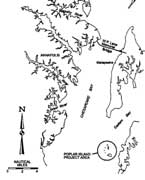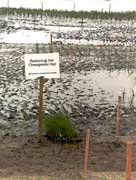|
|
 |
|||||||
|
Volume 13, Issue 32 ~ August 11 - 17, 2005
|
||||||||

|
 Rising from the Bay Rising from the Bayby Helena Mann-Melnitchenko with Katherine Mann This was no Sunday picnic in the park. The volunteers, some 15 of them, were up to their ankles in mud. And the tide was coming in. On their last day to plant cord grass and the wider leafed Spartina alterniflora on Poplar Island, the water was too high to work. No matter; there was still a job to do. To keep Canada geese from landing and undoing a week’s worth of plantings, they helped make goose exclusion fences, some pounding in stakes, others stringing fences or tying on flags. Under their hands, Poplar Island was reemerging from the Bay. Hungry Water Chesapeake Bay gnaws at shores and swallows whole islands: some 10,000 island acres disappeared in the last 150 years. Only remnants remain of Sharp’s Island, Holland Island and Poplar Island. Smith, Tangier and Tilghman: Will they be next to go? The rise in the Bay’s waters is predicted to overcome them in this century. Nature, in the form of hurricanes and storms, adds her fury, doing tremendous damage to the shoreline and the islands of the Bay. Hurricane Isabel, which hit our shores two years ago this September, was particularly ferocious. In that regard, the Bay is at the mercy of nature, and there’s not much we can do about it. But we can do something about global warming, which is responsible for an accelerated rise in seas of one foot just this past century. In this new century, sea level is predicted to rise two to three feet. The destruction of our planet by humankind is nothing new. Think of the Dust Bowl of the 1930s, when new technology, in the form of the tractor, scoured America’s Plains. Scientists say this new human threat, global warming, will devastate our entire planet as the water levels rise and our shorelines, from Antarctica to Alaska are inundated. There will be consequences for many species, Homo sapiens included. The first step in solving a problem is to recognize it. We now know we have a problem. Perhaps we’re the Dutch boy with his hand in the dike, but the good news is that we are making an attempt, albeit a small one, to give back to the planet what we have taken away. The restoration of Poplar Island, two miles west of Tilghman Island in the mid-Bay, is just that kind of attempt. Anchored in History
First, Daniel Cugley pastured a large herd of pigs on Popeley’s Island, as it was known then, in 1632. In the summer of 1637, the usually peaceful Nanticoke Indians — or perhaps it was the warlike Susquehannocks who carried on a lively fur trade on Kent Island — went on the warpath. They massacred the wife, child and servants of Richard Thompson, who had settled on the island in 1631. Thompson himself escaped the massacre as he was on a fur-trading voyage at the time. Except for the war of 1812, when the British fleet occupied the island, the 19th century was a quiet time. But not quiet in every way. In 1844, a thousand black cats were brought to the island by an owner who thought to trade black cat fur with China. The venture came to naught as the Bay froze that December and the cats escaped. Yet the island thrived. By the 1880s, almost 100 watermen called it home, and the tulip poplars that graced the island helped change its name. A school, church, sawmill and a post office supported the community. Even then, the Bay was eating the island away, and the community shrank. But the isolated island was still good for sneaky business. During Prohibition, Poplar was home to a large moonshine operation. When the sheriff of Talbot County busted the stills, huge amounts of whisky mixed with the waters of the Bay. In 1929, prominent Democrats bought what remained of Poplar and Jefferson Islands. In 1931, a Jefferson Island club was built for political discussion and elegant entertaining. Close to Washington yet private, location was again a plus. President Franklin Delano Roosevelt, Vice President Harry Truman and their advisers strategized World War II there, on what was by that time several small, shrinking islands. Eventually the Smithsonian bought the remnants to conduct studies on seabird populations. Now Poplar Island is owned by the state of Maryland, which has worked to keep its investment from trickling grain by grain into the Bay. How Do You Restore an Island? By the end of the 20th century, the island that once welcomed a president had shrunk to just four acres of land, barely rising out of the Bay. The Poplar Island Restoration Project began in 1996, raising the island from oblivion with spoils dredged from the upper Chesapeake Bay approach channels to Baltimore.  Rebuilding the island is the secondary result of the massive public-works project. Over 17 years, $340 million will be spent, primarily to keep ships navigating to the port of Baltimore. The port, one of the largest in the nation, contributes $1.4 billion to Maryland’s economy each year. Poplar Island — which makes its contribution in wildlife, not dollars — is the lucky recipient. Rebuilt to its 1846 footprint of 1,140 acres with clean dredge material from the Bay — not the toxic-heavy Inner Harbor — the island will eventually regain its wildlife habitat. The island is being built in two levels. First the 570 acres of inter-tidal wetlands or lowlands are restored, barge load by barge load with millions of cubic yards of Bay-bottom muck. Over the years, a hi  gher, reforested region of 570 more acres will rise some 23 feet above sea level. By 2014, Poplar Island will be richer by 40 million cubic yards of dredge spoils. gher, reforested region of 570 more acres will rise some 23 feet above sea level. By 2014, Poplar Island will be richer by 40 million cubic yards of dredge spoils.To rebuild the vanishing island, the Army Corps of Engineers barged in a flotilla of heavy-duty earth-moving equipment and maintains a routine of muck delivery service. Starting in September or October and lasting through March, the Corps ships dredge spoils from the navigation channels to Poplar Island in scows, large flat-bottomed boats with square sides. At the island, an unloader empties the scows and pumps the mud into containment dikes built on low marshy ground. Pipes allow for the natural flow of tidal water. Way before the first barge could be loaded, in 2001, the plan had to pass years of environmental tests because Maryland carefully regulates the disposition of dredge spoils. In 2001, the state also outlawed open-water dumping, which Virginia allows in its part of Chesapeake Bay. “We work closely with the regulatory agencies to ensure that all environmental standards are met,” said Scott D. Johnson, Poplar Island project manager for the Army Corps of Engineers. The Corps of Engineers got the job because they’re responsible for keeping shipping channels open. In turn, the Corps pays three-quarters of the $340-million project with federal dollars. Maryland’s share of the costs is $85 million. Besides the Corps, many federal and state agencies are working on the project. Among them are the Maryland Port Administration and the Baltimore Aquarium, which organized its own corps of volunteers this summer to plant six acres of sea grasses to lure wildlife. Eventually the uplands will also be reforested with native trees and bushes. Once the island has been replanted, the wetland dikes will be broken through and there will be free flow not only of the tide but also of animal life. Currently, some small animals — silversides and killifish, shrimp and some small crabs — make their way through the four-foot pipes of the dikes. Terrapin turtles and water birds — blue heron, cormorants, egrets, nesting terns and red-winged blackbirds — are making their home on this scrap of land. Islands in the Bay have fewer predators, including humans, so they are very desirable nesting sites. Baltimore Aquarium Brings a Planting Crew “I always enjoy introducing our summer interns to the wetlands,” Angie Ashley, the National Aquarium’s Chesapeake Bay program manager said. “Many have not had much field experience. In the early weeks, they are skittish and try to stay clean. But by the end of the project they are fully embracing the mud.” For seven years, the aquarium has enlisted volunteers to restore Bay tidal wetlands. This year, when the first wetland cell at Poplar Island was ready to be planted, the Army Corps invited the aquarium to lead the effort. “We had great weather, wonderful volunteers and all supplies were delivered on time, thanks to many months of diligent planning by all of the project partners,” Ashley said. In 10 days at the end of June, some 400 volunteered a day or more to plant 150,000 sprigs of marsh grass on six acres of Poplar Island. These volunteers got close and personal with the Bay: They heard it, touched it and smelled it. Now, Ashley said, “they will feel compelled to protect it because they understand the Bay and its immense importance.” Katherine Mann, one of those volunteers, kept a journal of her days of touching, hearing and smelling the Bay. “On Tuesday, June 28 my first day of the three for which I had volunteered,” she wrote, “the Terrapin was filled with some 30 men, women and children of all ages and sizes.” The Terrapin, a duel-engine craft that can move sideways as well as forward and backward, transported volunteers from Tilghman Island to Poplar. Volunteer Katherine Mann’s Journal Some had traveled three to four hours: grandparents with grandchildren, uncles from Pittsburgh with their Maryland nieces, teachers on summer vacations. In shorts or jeans, T-shirts and hats, they all looked ready to go. Some were old hands: This planting project had started the previous Friday. As we approached Coaches, Jefferson and Poplar islands, it seemed that there were forested and flat parts. It proved to be an illusion. Only Coaches and Jefferson are forested; Poplar is flat and barren, but it is an active construction site. Huge machinery gave it the appearance of a lunar landscape. Buses carry volunteers to the planting site, Cell D, where the aquarium had Kevlar gardening gloves, dive booties, water and granola bars set out. The team leader demonstrated the planting technique. A PVC pipe grid was laid down to guide our planting. We used dibble bars to poke holes in the soft mud, one foot apart for Spartina patins, two feet apart for Spartina alterniflora. Each planting team had three volunteers. The first person dug the hole, then moved over to the next spot. The second added the fertilizer, and the third put the plant in and covered it
It was hot and sticky, and we were glad of our water breaks and lunch under the tent. Some of us left at 3pm with the construction workers. We were covered in mud but chatting happily. There was a sense of camaraderie; we were part of a historic project. I didn’t wake up stiff and sore, next day, as I was afraid, but no matter how hard I scrubbed the night before, there was mud under my fingernails, a badge of sorts. It was overcast and breezy on the way over to Tilghman Island again. Perfect planting weather. We took a smaller boat out, one of the aquarium’s. It rained by lunchtime, and rain jackets were provided to those who had not packed them. “This must be like planting rice in the rice paddies,” someone joked, as we raced against the tide before it became too swampy. Day three was sunny with not a cloud in the sky. The rain had scrubbed the air clean. I had forgotten my lunch and received many offers to share from the other 30 volunteers. I did not go hungry. By now, I was an old pro at planting and knew I wanted to come back the next day. There were to be fewer volunteers on Saturday, which coincided with the Tilghman Island Seafood Festival. Just 15 volunteers came that morning. When we arrived, the waters in our cell were much higher than the previous days due to a full moon two days before. It was goose exclusion fences that Saturday. A new sight greeted us: several dead trees, snags, erected on the central island of our cell. The organizers hope that they will encourage brown pelicans to nest there.  A lot of progress was made during the week, and as we made our way to Tilghman, I pondered the future of Poplar Island. I would love to revisit it again after the Spartina grasses, which thrive in salt marshes, have taken root. My land across from Tilghman Island is also being eroded by the rising levels of the Bay. My husband and I have already planted some sea grasses. A lot of progress was made during the week, and as we made our way to Tilghman, I pondered the future of Poplar Island. I would love to revisit it again after the Spartina grasses, which thrive in salt marshes, have taken root. My land across from Tilghman Island is also being eroded by the rising levels of the Bay. My husband and I have already planted some sea grasses. For me, these four days on Poplar were a chance to help the Bay on a local basis. On a larger scale, the Poplar Island refuge will provide a place for birds, shellfish, and fish to have a safe home, all critical pieces of why we love the Bay. The Poplar Island Project is a small way of reclaiming Chesapeake Bay. I have already signed up for another similar replanting project: Planting and monitoring the aptly named Barren Island, near the Blackwater Wildlife Refuge in September. Any other volunteers out there? Popular Poplar Not only Mann and her 400 grass-planting partners but also federal, state, local, environmental groups and academia are partners in the restoration project. “Perhaps the most challenging part of this project and the best is coordinating the construction with the ongoing wildlife activity,” said the Corps’ Johnson. From the beginning of construction, he explained, birds and diamond-back terrapins have selected Poplar Island as nesting sites.  “Coupled with the eagle nest and heron rookery on the adjacent Coaches Island, protecting and working around this activity is a constant challenge,” Johnson said. “Coupled with the eagle nest and heron rookery on the adjacent Coaches Island, protecting and working around this activity is a constant challenge,” Johnson said.The project is supported by the entire Maryland delegation, and most environmental groups, more so as the project progresses. The National Fish and Wildlife Federation and the Chesapeake Bay Trust, among many others, have funded replanting. In another sign of success, Blackwater Wildlife Refuge is seeking dredged material to restore its habitat. After four years of barging in dredge spoils, Poplar Island is about 30 percent complete. Forty-five tidal-marsh acres of the planned 570 have been planted. The plan is to complete about 50 to 75 acres per year starting in 2007. The remaining upland habitat will be planted in 2015 after the final placement and consolidation. As the restoration of Poplar Island progresses, many Marylanders see it out there in the Bay, but hundreds watch more closely. The hot sweaty volunteers who toiled there replanting the island have made it their own. Join staff from the National Aquarium in Baltimore from one to four days September 8-12 to plant marsh grasses and restore a wetland on Barren Island. Volunteers under 18 need an adult partner: 410-659-4247 [email protected]
|
|||||||
|
|
||||||||
|
© COPYRIGHT 2004 by New Bay Enterprises, Inc. All rights reserved. |




 Never Too Much of a Good Thing
Never Too Much of a Good Thing About the Authors
About the Authors